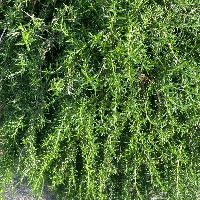
In any great garden design, the icing on the cake is the covering of the ground – that last finishing touch once you have the trees, shrubs and climbers in place. In this two-part series, plant expert Penny Cliffin offers tips on the top groundcovers for gardens of every kind
Ground covers have many functions – weed supression, water conservation, promoting microbial life, insect and lizard habitat, and food for pollinators and people.
Different groundcovers (plants that can form massed effects of less than a metre in height) suit different growing conditions and vary in the scale of space they will fill.
Below is a guide to ground cover options with an ecological/sustainable focus – food for pollinating or beneficial for insects, lizards, birds or people.
 |  |
African daisy (Arctotis ‘Burgundy Belle’) A low herbaceous perennial with a spreading habit and showy dark pink flowers produced from winter through summer that contrast well with the grey foliage. It prefers full sun on a well-drained site and is tolerant of dry periods, coastal conditions, moderate frost, cool climates, and some wind. ‘Burgundy Belle’ is commonly mass planted either as a groundcover or on a bank, included in coastal gardens, planted along the edge of a path or in borders. 0.3 x 0.7m | Cranesbill (Geranium sanguineum) An eye-catching rhizomatous deciduous perennial with large, bright, magenta-pink flowers in spring/summer and palmate leaves which turn red in autumn. This hardy geranium is reliable, easy to grow, provides long-lasting colour and attracts pollinators. It performs best in full sun or part shade and in welldrained soils. This plant is not fussy about climate conditions and soils provided they are well-drained. It is clay soil and drought tolerant. 0.45 x 0.6m |
 |  |
Creeping wire vine (Muehlenbeckia axillaris) Dense creeping ground cover with wiry stems and small dark-green leaves. Flowers prolifically in summer with masses of small cream flowers, attractive to native butterflies. Also provides habitat for lizards. Tolerant of hot, dry conditions. Not as vigorous as M. complexa. Semi-deciduous. Hardy. Prefers full sun to part shade. 0.2m x 1m | Creeping rosemary (Rosemarinus prostata) A dense evergreen fast-growing ground cover. Its fragrant foliage and mauve flowers in summer attract bees and other pollinators to the garden. Trim to retain size and shape. Useful spilling over retaining walls or banks, even in coastal areas. Tastes great with roast potatoes and lamb. Evergreen. Hardy. Prefers full sun. 0.3 x 1.5m |
 |  |
Wild strawberries (Fragaria virginiana for sun) A low-growing, spreading perennial forming rosettes of tri-foliate, toothed, bright green leaves. Prefers full sun to part shade. In spring to early summer, small, five-petaled white flowers attract pollinating insects. They are followed by a crop of tiny, bright red berries, rich of a sweet tart flavour. This plant is easy to cultivate, and it will spread to form a loose ground cover in open areas. The foliage is more resistant to foliar disease than most cultivated strawberries. This plant spreads by runners to form large colonies over time. Full sun to part shade. 0.15 x 0.6m *Use woodland Fragaria vesca for shady conditions. | Catmint (Nepeta x fraassenii) A vigorous, evergreen, herbaceous perennial that forms a dense, rounded clump of small, gray-green leaves. From early summer into early fall, the foliage is topped with wellbranched stems boasting showy spikes and pale purple flowers. Low maintenance, drought tolerant, and boasting long-lasting blooms, it works well in large drifts along a walkway to create a garden space that overflows with colour and provides a mint scent when bruised. Attractive to pollinators and cats. Performs best in average, dry to medium, well-drained soils in full sun to part shade. 0.6 x 0.9m |
 |  |
Bugleweed (Ajuga reptans) An herbaceous perennial grown for both its foliage and flowers. Its dark green leaves often take on purple and bronze tones, particularly during cooler periods and serve as an attractive backdrop to the showy spikes of blue flowers which rise above the foliage spring through summer. Prefers full sun or partial shade on a well-drained site that does not dry out. Frost-hardy, it tolerates coastal environments and reasonable levels of shade. 0.2 x 0.8m | Snow-in-summer (Cerastium tomentosum) A low-growing, short-lived perennial that forms a dense mat of silvery-gray foliage and has star-like, white flowers in spring. Evergreen, it spreads quickly by reseeding itself and makes a great ground cover for sunny areas. 0.3 x 0.6m |
 | Lemon thyme (Thymus citriodorus) An aromatic, bushy, evergreen subshrub primarily grown as a culinary herb. Prefers full sun and is tolerant of alkaline and sandy soils. Tiny, lemon scented leaves. Grows more upright than other thyme varieties. Its small, tubular, lavenderpink flowers in early summer are attractive to bees and butterflies. 0.3 x 0.6m |

Penny Cliffin has a degree in horticulture, practiced as a garden designer and has over 20 years lecturing experience, all of which gives her extensive plant knowledge.
Penny is also a founder, accredited academic member and past President of the Garden Design Society of New Zealand (GDSNZ).
